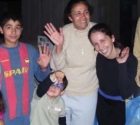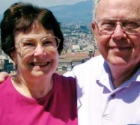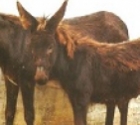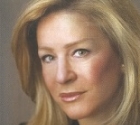
Using numerous types of grain, kibbutz farmer, Peter Viner, created a 17 acre work of unnatural natural art celebrating the 60th anniversary of the State of Israel.
Recently his matured grain composition came under the blades of a Jezreel valley combine harvester, much of it ending up in loaves of bread or breakfast cereal boxes.
Locals, who took the birds-eye seats on top of the Gilboa mountain, overlooking the valley below and opposite kibbutz Ein Harod, where Viner designed, planted and nurtured the massive design featuring the number sixty and the Hebrew lettering L’Israel (to Israel) underneath, saw the artwork grow and change colors as it developed over the winter and spring months.
With the field as his canvas and the grains as his paintbrush, the innovative farmer has created a dozen such works of art in the field – including one in 1994 following the Israel-Jordan peace treaty. On the main road alongside the kibbutz field, a large road sign tells one that the Sheik Hussein bridge over the River Jordan is only a short distance down the road in the Jordan valley from where Viner’s kibbutz, Maoz Haim is situated.
Viner starts by working with a graphic designer and then he figures out which grains to use and what quantities of each type to give the different hues that make the designs stand out.
He plants and then reaps his living work of art viewed by thousands of visitors to the Mt. Gilboa national park high above that part of the valley.
Moshe Kohn from the nearby town of Afula admits to periodically making a point of visiting the observation platforms on top of Mt. Gilboa to watch the work of art in progress as it sprouts from the valley soil.
“It is such an amazing feat and so original. I have brought visitors from abroad to see this salute in the soil to Israel, and have even convinced friends from Beersheva to make a special journey to see Peter Viner’s unique creation, which is a shame to miss,” said Kohn whose five-year-old grandson kept asking him how it was done.
“With great patience and much talent,” answered his knowing grandfather, a retired farmer.
 ESRA ASHKELON DONATED GOODS
ESRA ASHKELON DONATED GOODS  DEFIANCE TEL AVIV STYLE
DEFIANCE TEL AVIV STYLE  THE SPIRIT OF ESRA-JULES AND PERLA FOX- EXCEPTIONAL BENEFACTORS
THE SPIRIT OF ESRA-JULES AND PERLA FOX- EXCEPTIONAL BENEFACTORS A new website in English - on Volunteering - Launched in Israel
A new website in English - on Volunteering - Launched in Israel Help Needed for Abused Horses and Donkeys
Help Needed for Abused Horses and Donkeys Heather's Heseg
Heather's Heseg Lydia Aisenberg
Lydia Aisenberg